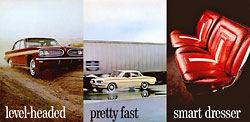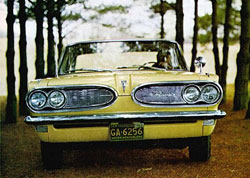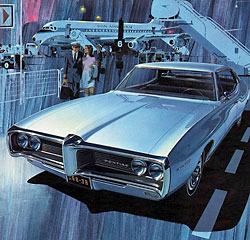1961-1973 Tempest, T-37
The Volkswagen Beetle flew in under the radar in the late 1950s and gave the American car market a jolt. Customers responded to the compact car’s efficiency and maneuverability, especially in urban areas. Detroit wasted no time in countering the German import with its own compacts, including the Ford Falcon and Chevy Corvair, in 1960.
 GM’s other divisions introduced small cars a year later, with the 1961-63 Pontiac Tempest arguably the most unique. Its unique rear transaxle, which was connected to the front-mounted engine with a “rope drive” torque transfer system housed in a torque tube, bridged the technology gap between the conventional layout of the Falcon and air-cooled, rear-engine design of the Corvair.
GM’s other divisions introduced small cars a year later, with the 1961-63 Pontiac Tempest arguably the most unique. Its unique rear transaxle, which was connected to the front-mounted engine with a “rope drive” torque transfer system housed in a torque tube, bridged the technology gap between the conventional layout of the Falcon and air-cooled, rear-engine design of the Corvair.
In many respects, the Tempest was technologically superior to the Corvair. The rear transaxle contributed to a front/rear weight balance of nearly 50/50, which worked with an advanced four-wheel independent suspension system to deliver excellent ride quality and sharp handling. There was no interior transmission hump, either, which freed up space in the compact sedan. Sister cars from Oldsmobile and Buick offered conventional front engine/transmission layouts.
Half of an Eight
 The quirkiness of the original Tempest also included the “Trophy 4” inline-four, which was essentially half of a Pontiac 389 V-8 (the right cylinder bank). There was even an aluminum four-cylinder (a Buick design) offered in 1961 and ’62. In 1963 12 Super Duty models were built for racing in NHRA’s Factory Experimental class and were equipped with 421 V-8s and a unique “Powershift” transaxle that essentially married a pair of two-speed automatics.
The quirkiness of the original Tempest also included the “Trophy 4” inline-four, which was essentially half of a Pontiac 389 V-8 (the right cylinder bank). There was even an aluminum four-cylinder (a Buick design) offered in 1961 and ’62. In 1963 12 Super Duty models were built for racing in NHRA’s Factory Experimental class and were equipped with 421 V-8s and a unique “Powershift” transaxle that essentially married a pair of two-speed automatics.
The Tempest’s innovations didn’t go unnoticed. It was dubbed Motor Trend Car of Year in 1961, helping the company advance its image as innovative and more exciting. Sales were good during the Tempest’s early years, but didn’t set the market on fire.
The compact market proved itself to be a bit compact by the mid-1960s and a crowded field saw comparatively marginal sales for many models.  Pontiac exited the field in 1964 when it re-launched the Tempest as a midsize car – dubbed “intermediate” in its day. The quirky rear transaxle, rope drive system and even the half-a-389 four-cylinder were dropped in favor of a more conventional front-engine/front-transmission layout. Engine choices included a Chevy-derived 215-cid straight six and Pontiac’s 326 V-8. The 389 would power the Tempest-based GTO that defied corporate edicts and push the muscle car era into full swing.
Pontiac exited the field in 1964 when it re-launched the Tempest as a midsize car – dubbed “intermediate” in its day. The quirky rear transaxle, rope drive system and even the half-a-389 four-cylinder were dropped in favor of a more conventional front-engine/front-transmission layout. Engine choices included a Chevy-derived 215-cid straight six and Pontiac’s 326 V-8. The 389 would power the Tempest-based GTO that defied corporate edicts and push the muscle car era into full swing.
In 1966 an overhead-cam six replaced the Chevy-based six and the 326 was replaced in 1968 by a larger 350-inch V-8, ratcheting up the car’s performance across the board. The “OHC” six, as it was called, brought back some engineering innovation to the brand, as it was the only American overhead-cam engine on the market.
A-body Basics
 The 1964 Tempest was built on GM’s new A-body platform, which featured a strong perimeter frame and coil-spring suspension. It’s long, lean look was updated in 1968 with a rounder, semi-fastback style that lasted on the A-body platform through 1972, but the Tempest name bowed out at the close of the 1970 model year. It was replaced in the lineup by the entry-level T-37, which was introduced in mid-1970 as a low-priced two-door hardtop. The T-37 – and the performance-oriented GT-37 – was offered only in 1970 and ’71.
The 1964 Tempest was built on GM’s new A-body platform, which featured a strong perimeter frame and coil-spring suspension. It’s long, lean look was updated in 1968 with a rounder, semi-fastback style that lasted on the A-body platform through 1972, but the Tempest name bowed out at the close of the 1970 model year. It was replaced in the lineup by the entry-level T-37, which was introduced in mid-1970 as a low-priced two-door hardtop. The T-37 – and the performance-oriented GT-37 – was offered only in 1970 and ’71.
Although the Tempest was discontinued in America after 1970, its name resurfaced in Canada as a Pontiac version of the Chevy Corsica, from 1987-91.
The Tempest’s relatively short production run was marked by its innovative engineering and delivery of great performance at a low price. As one of the industry’s largest restoration suppliers, Original Parts Group offers thousands of 1961-63 and 1964-70 A-body Tempest parts and accessories, including T-37, with new parts added daily. Our extensive catalog offers nearly everything from sheet metal, chrome and upholstery to engine parts and the hard-to-find details to finish a restoration with show-winning attention to detail. Our prices make that restoration more affordable, too! Shop online or order your OPGI 1961-71 Tempest parts catalog today!